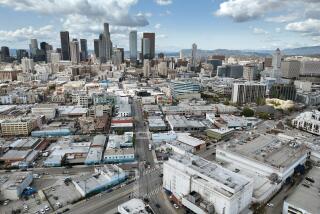The 25-Downtowns Solution : Livability and Municipal Finance Prosper from Patterns of Growth
- Share via
Branch libraries are curtailing hours. Parks are not being maintained. There is less and less federal money for cities. Nearly every day we read about the growing need and diminished resources of our local governments. Hamstrung by Proposition 13 limitations, large and small cities are in a race like never before to increase their tax base without raising residential taxes.
Yet at the same time, there has been an economic transformation in the five-county Greater Los Angeles area. This shift in the region’s economy from one big city surrounded by bedroom communities to a collection of economically strong areas has increased certain cities’ commercial and industrial tax base. The continuation of this change will allow other local communities, if they want this new commercial and industrial tax base, to become centers of future development. However, they must first recognize the opportunity and take action.
Not since the Industrial Revolution changed our 18th-Century agricultural trading towns into 19th-Century industrial cities have our urbanized areas been more dramatically transformed than of late. As our economy moves into the “post-industrial” era, our former industrial cities are being transformed into decentralized metropolitan areas. These greatly enlarged metropolitan areas occupy 10 to 20 times the land area of their industrial ancestors. As a result of this decentralizing transformation, there are many downtowns--concentrations of employment, shopping, culture, and decision-making--not just one.
The Greater Los Angeles area now has 25 downtowns, with downtown Los Angeles just first among equals. And in the future, downtown Los Angeles may not even be first. Consider office space. In 1960, downtown Los Angeles had 60% of all office space in Southern California.Today, it has 14% and it is absorbing only 9% of the annual new space, so it will continue to shrink relatively. This is in spite of the fact that downtown has been completely rebuilt in the last 20 years and is now impressive enough to appear on our television screens every Thursday night on “L.A. Law.”
Where are the major new office concentrations emerging? Look at Warner Center, Burbank, Glendale, Pasadena, the San Gabriel Valley, South Bay, downtown Long Beach, and all of the emerging downtowns of Orange County, including Huntington Beach, Fullerton, Anaheim, South County, and the Newport Beach/Costa Mesa/Irvine complex. In fact, Newport Beach/Costa Mesa/Irvine is the second-largest downtown in Southern California and is the fastest-growing office-dominated employment center. It is growing 50% faster than downtown Los Angeles and will be larger than downtown Los Angeles sometime in the 1990s. From a shopping perspective, this area is already the largest. Just one of Newport Beach/Costa Mesa/Irvine’s shopping centers, South Coast Plaza, has more sales than all of Beverly Hills. The benefit of South Coast Plaza to the city of Costa Mesa is obvious.
The issues of air pollution, traffic congestion and achieving a higher level of jobs and housing are being battled at the regional levels among the Air Quality Management District, the Southern California Assn. of Governments and the various counties and cities. An equally dramatic jockeying for power is taking shape among the region’s smaller cities as they compete for new tax-producing commercial and industrial development.
Why is this shift from one downtown to 25 of interest to the average citizen? For one thing, it will affect everyone’s housing or employment decision. In 1960, the average commute in Southern California was about 30 minutes. In the 1970s, after nearly 4 million more people moved to the Greater Los Angeles area, the average commute was still about 30 minutes. People moved closer to their employment and their employment moved closer to home.
But in the 1980s, the average commute time has been increasing due to constraints on freeway capacity and economic limits on affordable housing in new major employment centers, especially West Los Angeles and Orange County. To alleviate traffic congestion, even more people need to live closer to their work or work closer to their homes--which decentralized downtowns encourage.
While decentralized downtowns are positive if you can live near where you work, there are major short- and medium-term problems caused by this trend. For one, these downtowns have sprung up very rapidly. In the absence of good planning, the result has been poor urban design, inadequate public services and traffic congestion. In addition, the character of these new downtowns is generally sterile. But both the planning and quality-of-life issues will be resolved if the public and private sector commit to solving them.
There is no law of nature dictating precisely where a new downtown will be, so there is a lot that local officials can do to bring one or a portion of one to their city. Developing master plans for concentrated use of both office and industrial development, for instance, can be a step in the right direction. Then, if those developments are mixed in with housing, hotels, shopping centers and cultural and government buildings, all the elements of a thriving downtown would be in place--but a lot closer to home.
As the Greater Los Angeles area continues to reorganize itself to deal with traffic, pollution, housing shortages and other problems, suburban officials need to recognize that the region also offers development opportunities that can help mitigate these problems--and put some dollars in the municipal coffers.
More to Read
Sign up for Essential California
The most important California stories and recommendations in your inbox every morning.
You may occasionally receive promotional content from the Los Angeles Times.










